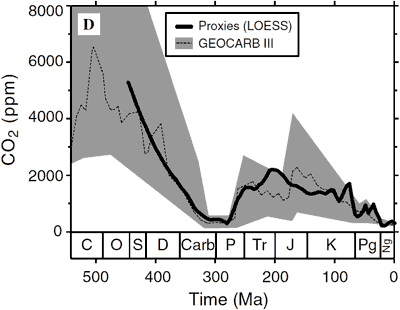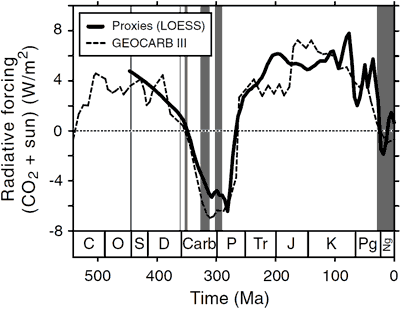
Figure 1: Atmospheric CO2 through the Phanerozoic. Comparison of the predictions of GEOCARB carbon cycle model (dashed line) with a smoothed representation of the proxy record (solid line). Source: Royer 2006.
We've seen empirical evidence that more CO2 causes an enhanced greenhouse effect. However, when we look back over the Earth's history, we see many periods where CO2 is higher than current levels of 384 ppm. Intriguingly, for some of those periods where CO2 was higher than now, the planet experienced widespread regions of glaciation. Does this contradict the warming effect of CO2?
No, it doesn't, for one simple reason. CO2 is not the only driver of climate. To understand past climate, we need to look at other forcings that drive climate. One paper that does this is CO2-forced climate thresholds during the Phanerozoic (Royer 2006). It pieces together 490 proxy records to construct a 540 million year timeline of CO2 levels. This period is known as the Phanerozoic eon.

Figure 1: Atmospheric CO2 through the Phanerozoic. Comparison of the predictions of GEOCARB carbon cycle model (dashed line) with a smoothed representation of the proxy record (solid line). Source: Royer 2006.
CO2 levels reach some spectacular values in the deep past, possibly topping over 5000 ppm in the late Ordovician, around 440 million years ago. However, solar activity also falls as you go further back. In the early Phanerozoic, the solar constant was about 4% less than current levels. Royer 2006 combined the radiative forcing from CO2 and solar variations to find their net effect on climate. The result is shown in Figure 2. Cooler climate is indicated by shaded areas which are periods of geographically widespread ice.

Figure 2: Combined radiative forcing from CO2 and sun through the Phanerozoic. Values are expressed relative to pre-industrial conditions (CO2 = 280 ppm; solar luminosity = 342 W/m2); a reference line of zero is given for clarity. The dark shaded bands correspond to periods with strong evidence for geographically widespread ice.
They find that periods of low CO2 correlate with long-lived, extensive continental glaciations while periods of high CO2 don't overlap with these glaciations. They also explore the concept of the CO2-ice threshold - the CO2 level required to initiate a glaciation. When the sun is less active, the CO2-ice threshold is much higher. For example, if the CO2-ice threshold for present-day Earth is 500 ppm, the equivalent threshold during the Late Ordovician (450 million years ago) would be 3000 ppm.
A follow up paper Climate sensitivity constrained by CO2 concentrations over the past 420 million years (Royer 2007) offers a more quantitative comparison of global temperatures and CO2 levels over the Phanerozoic. They couple the CO2 record to temperature and find a climate sensitivity of 2.8°C. The results "indicate that a weak radiative forcing by carbon dioxide is highly unlikely" and that a "climate sensitivity greater than 1.5°C has probably been a robust feature of the Earth’s climate system over the past 420 million years"
So we see that comparisons of present day climate to periods 500 million years ago need to take into account the fact that the sun was 4% less active than now. What about times closer to home? The most recent period when CO2 levels were as high as today was around 15 million years ago, during the Middle Miocene. CO2 levels were at about 400 ppm. What was the climate like at the time? Global temperatures were 5 to 10 degrees Fahrenheit higher than they are today. Sea level was approximately 75 to 120 feet higher. There was no permanent sea ice cap in the Arctic and very little ice on Antarctica and Greenland. The close coupling between CO2 and climate led the author to conclude that "geological observations that we now have for the last 20 million years lend strong support to the idea that carbon dioxide is an important agent for driving climate change throughout Earth's history." (Tripati 2009).
To sum up, Dana Royer says it best: "the geologic record contains a treasure trove of 'alternative Earths' that allow scientists to study how the various components of the Earth system respond to a range of climatic forcings." Past periods of higher CO2 do not contradict the notion that CO2 warms global temperatures. On the contrary, they confirm the close coupling between CO2 and climate.
Posted by John Cook on Tuesday, 27 October, 2009
 |
The Skeptical Science website by Skeptical Science is licensed under a Creative Commons Attribution 3.0 Unported License. |